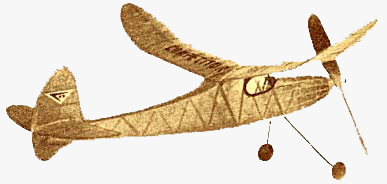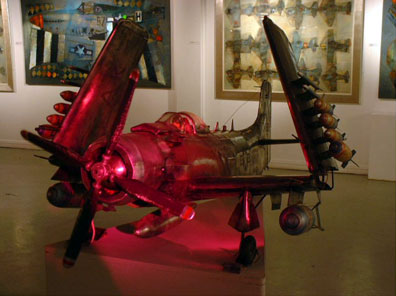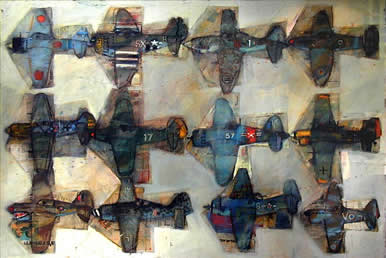Heavier Than Air
'The Disenchanted Toy Shop'
by
Tim Neil
Tom McKendrick was born in Clydebank in 1948, 3 years after the end of the Second World War, three years before the commencement of commercial jet services, and approximately ten before the end of Clydeside's last boom in ship construction.
What McKendrick grew up with was a place of quite extraordinary busyness. A place in which ships were built, post was sorted, trains interchanged and sewing machines were made, a place in which there was every kind of career to choose from apart from the highly paid. Now Clydebank sleeps for a living. People work elsewhere, or are unemployed at home, or are busy dying from the varieties of asbestos they were exposed to in Singer's or the shipyards - the other choice on offer in (pick a year) 1960: what colour of the filthy stuff to work with, white or brown.
 McKendrick grew up, as did everybody in Britain over the age of thirty, with an ambiguous victory. We won the war and lost the peace, and he will have watched with the same bemusement as Britain declined quietly from its imperial and industrial zeniths to become this place where we live now, rather guiltily regretting something that we've learnt, since history dispensed with it on our behalf, was shameful; an empire that retreated, leaving behind it Ulsters everywhere.
McKendrick grew up, as did everybody in Britain over the age of thirty, with an ambiguous victory. We won the war and lost the peace, and he will have watched with the same bemusement as Britain declined quietly from its imperial and industrial zeniths to become this place where we live now, rather guiltily regretting something that we've learnt, since history dispensed with it on our behalf, was shameful; an empire that retreated, leaving behind it Ulsters everywhere.
Arriving at the years of majority, most British men find themselves with a thoroughly inappropriate vocabulary. Achtung! Englander! Teufel! Ein Schpitfeur! Gott in Himmel! More than the vocabulary, there's a body of myths; bravery's, acts of magnificent defiance and glorious self-sacrifice, all drawn from the pages of the Hotspur, the War Picture Library and Commando Comics.
The Germans will have told such stories too, the Americans and the Japanese; stories for children, the essential moral of which modulates gently and imperceptibly as the age of the audience grows until, for adults, it becomes what Wilfred Owen called the old lie: dulce et decorum est, pro patria mori. It is sweet and fitting to die for your country. This is a vocabulary, a library, which McKendrick remains willing to use.
In Heavier Than Air we find The Last Smile of Lieutenant Kanno Naoshi - a Hotspur story, yes, but for a Japanese audience. Kanno was a Japanese ace with 48 kills to his credit. On his last flight he engaged the enemy B-24s; damaged and outnumbered, his wingmen tried to persuade him to follow them back to base. Kanno refused, smiled at them, and although he did not engage with the B-24s whilst still in his wingmen's sight he was never seen again.
In McKendrick's version he is still flying fifty years later, his Zero discoloured, the smile still fixed upon his face, the perfect enemy not yet found; the whole thing, in McKendrick's show, an animatronic with which Disney would be uncomfortable, as they would be with the All-American Big Tin Candy Bomber - which dumps upon the Vietnamese an unoppressive payload of sherbet rockets and soft toys. The airplanes, of course, are anatomically correct; only the history is deformed.
 When he was twelve, McKendrick proudly took several friends up the hill above the Holy City to watch the first flight of his KeilKraft competitor (32" wingspan, 10/6 from Dunn's); it flew perfectly, began a controlled stall on cue as the fuse mounted behind the tailplanes burnt through, and landed intact at the feet of an Alsatian, which ate it.
When he was twelve, McKendrick proudly took several friends up the hill above the Holy City to watch the first flight of his KeilKraft competitor (32" wingspan, 10/6 from Dunn's); it flew perfectly, began a controlled stall on cue as the fuse mounted behind the tailplanes burnt through, and landed intact at the feet of an Alsatian, which ate it.
As a child McKendrick will have been a willing victim of the Airfix romance; he would have been the boy that you were jealous of when you went round his house, because his models were immaculate, finished, and yours? Gluelumps, smear painted, wings not straight.
Your models were only bits of plastic, deformed trash, but Tom's could fly, you felt that when you looked at them; the world turned quietly upside down and shrunk, and Tom's Spitfire rolled above the Dover cliffs, Tom's Lancaster dropped fire bombs on Dresden, and that was good. The little pilot's plastic face could crack a smile, you felt, or scream, and as for any other questions, they could wait - whether what we did with all these things when they were real, was right; whether what we should feel when Lieutenant Naoshi's real last flight ended, brains oil metal mixed in the gashed foredeck of some USS in the Pacific, whether what we should feel was astonishment or horror - didn't matter yet. But matters now.
Everything that McKendrick makes remains, in part, a plaything. This is a peculiar category, because toys are part, not just of childhood, but of memory too, and memory is an aspic in which things are not preserved intact. They change. The modelled Lancaster and Zero are perfect, but stripped and pale - the mothballed memories that glitter underneath the dust sheets.

Big Tin Candy Bomber
The paintings, on the other hand, McKendrick makes into the other kinds of memories: more colourful than anything that really flew, shoved back into the forms in which they were first conceived - as plans, flattened and disassembled; remounted on the plastic sprues the kit-parts come on. Or they fly past, stuck in a world that's resolutely flat. You can see the newsprint that the child has made them from, but the flypasts make the warplanes into lepidoptera, butterflies caught and pinned and loosely classified, not by genus and species, but by when it was they were caught; and at the far end of his thinking Mckendrick makes the molluscs that evolve from the symbiosis between man and flying (killing) machine.The soft bodies onto which the wood and tintack aluminium and spinning steel are strapped, or the ball turret gunner, whose position, as he frantically scans the skies for enemy fighters, is foetal. Either way, the toyness of the things McKendrick makes reminds us how exactly it could be that that things like this get made at all. The real things, that is - the things McKendrick models from.

Paper Plane Flypast
All airplanes, McKendrick says, are flying bombs, all airplanes from any era are explosions waiting to happen, an assertion that September of last year proved conclusively. When Mohammed Atta arrived at his Florida flying school, and when he seated himself at the controls of his flight simulator, there will have been one part of him that dwelt with satisfaction upon the impending destruction of two buildings that stood, would fall, for America; an act, thoroughly and horrifyingly adult, of terror; but also at the controls there must have been an altogether younger Atta, a child ecstatic and at play. A twitch of the stick and the world turns. They're in the crosshairs, takatakatakataka.
This is something that McKendrick understands, whether his work concerns itself with ships, submarines or airplanes. The men who make and fly and fire were children once, and Tom was too, and what he makes is charged with a child's affection for the big, the big bang and the fantastically fiery crash; and with the adult's sorry knowledge that what sinks or shoots or crashes is no kind of toy at all. A child's eye and an adult's knowledge, or vice-versa. Smash! Bang!
Heavier Than Air Installation
Tragedy. We should face the facts, as McKendrick requires us to do. Kanno crashed, pointlessly, somewhere in the sea; the All-American Bombers dropped napalm on the Vietnamese, and in the beautiful and fragile Spads and Sopwiths and Fokkers the pilots had no parachutes, and died in horrifying numbers. McKendrick makes reference to The Death of the Ball Turret Gunner, but Heavier Than Air is more complicated than Jarrell's poem - has more to do with the smile with which skulls are usually, and thinly, disguised in wartime:
Tim Neil
'Heavier Than Air' was sponsored by HANNAY waste management and recycling services, and the Collins Gallery, University of Strathclyde. The artist is indebted to the late Bud Meade, ex ball gunner with the USAAF for sharing his thoughts and experience. You can read Bud's story at the link below.
Heavier Than Air Gallery | Bud Meade | Home